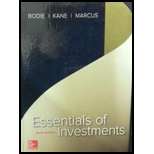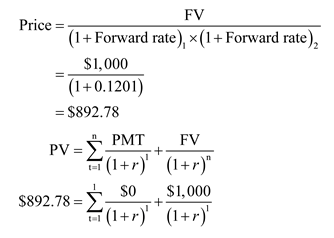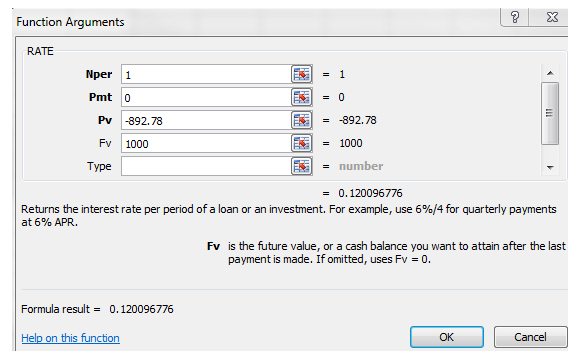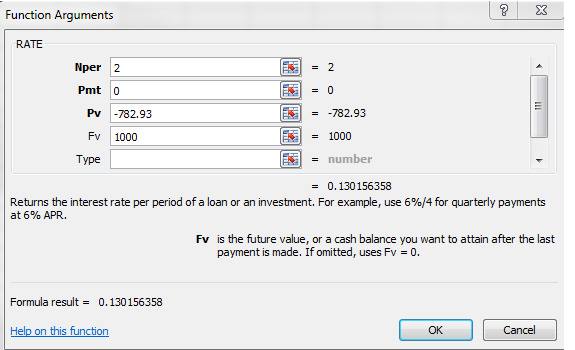
Concept explainers
(a)
Calculate the forward rate of zero-coupon bond with 11% yield to maturity and 2 years maturity.
Answer to Problem 40PS
The forward rates obtained for 2nd year is 12.01% and for 3rd year is 14.035, the yield to maturity for 3rd year is 13.02% and the expected return for three year bond is 10%.
Explanation of Solution
Given Information:
| Maturity(years) | Y TM |
| 1 | 10% |
| 2 | 11% |
| 3 | 12% |
Implied forward rates refer to the expected future movement of the interest rates by the market.
the
Yield to maturity of the bond can be calculated using the following formula:

The following information goes with all the parts of this question:
Table showing the current yield curve for zero-coupon bond:
| Maturity(years) | Y TM |
| 1 | 10% |
| 2 | 11% |
| 3 | 12% |
Calculate the forward rate of zero-coupon bond with 12% yield to maturity and 3 years maturity
Thus, the forward rates obtained for 2nd year is 12.01% and for 3rd year is 14.035
(b)
Calculate the YTM of the zero coupon bond 2nd years.
Answer to Problem 40PS
Theyield to maturity for 3rd year is 13.02%
Explanation of Solution

m:math>
Using RATE function in excel, Calculate the effective yield to maturity.
Enter the corresponding value in the field as below:

Calculate the YTM of the zero coupon bond 3rd years.
Using RATE function in excel, Calculate the effective yield to maturity.
Enter the corresponding value in the field as below:

Hence, the yield to maturity for 3rd year is 13.02%.
Thus, from the calculate it can be seen that the yieldcurve is increasing and upward sloping, and it implies that according to hypothesis expectationthere is a shift upward in the curve of the next year.
(c)
Calculate the price of the bond with 10% yield to maturity.
Answer to Problem 40PS
The expected return for three year bond is 10%.
Explanation of Solution
Calculate the price of the bond with 12% yield to maturity.
Calculate the price of the bond with 13% yield to maturity.
Calculate the total expected rate of return.
In the next year, the two year zero bond will be the one year zero bond, and thus it will sell for
In a similar manner the three year zero bond will become a two year bond and thus it will sell for $782.93 as calculate in part (b).
Expected return for two year bond is as below:
Thus, expected return for two year bond is 10%
Expected return for three year bond is as below:
Thus, expected return for three year bond is 10%.
Want to see more full solutions like this?
Chapter 10 Solutions
Essentials of Investments (The Mcgraw-hill/Irwin Series in Finance, Insurance, and Real Estate)
- High Hand Nursery has total assests of $900,000, current liabilities of $202,000, and long-term liabilities of $104,000. There is $90,000 in preferred stock outstanding. Twenty thousand shares of common stock have been issued. a. Compute book value (net worth) per share. b. If there is $40,000 in earnings available to common stockholders for dividends, and the firm's stock has a P/E of 22 times earnings per share, what is the current price of the stock? c. What is the ratio of market value per share to book value per share?arrow_forwardNeed the WACC % WACC and Optimal Capital Structure F. Pierce Products Inc. is considering changing its capital structure. F. Pierce currently has no debt and no preferred stock, but it would like to add some debt to take advantage of the tax shield. Its investment banker has indicated that the pre-tax cost of debt under various possible capital structures would be as follows: Market Debt-to-Value Ratio (wd) Market Equity-to-Value Ratio (ws) Market Debt-toEquity Ratio (D/S) Before-Tax Cost ofDebt (rd) 0.0 1.0 0.00 6.0 % 0.10 0.90 0.1111 6.4 0.20 0.80 0.2500 7.0 0.30 0.70 0.4286 8.2 0.40 0.60 0.6667 10.0 F. Pierce uses the CAPM to estimate its cost of common equity, rs, and at the time of the analaysis the risk-free rate is 5%, the market risk premium is 7%, and the company's tax rate is 25%. F. Pierce estimates that its beta now (which is "unlevered" because it currently has no debt) is 1.4. Based on this information, what…arrow_forwardNed's Co. has an average collection period of 45 days and an operating cycle of 130 days. It has a policy of keeping at least $10 on hand as a minimum cash balance, and has a beginning cash balance for the first quarter of $20. Beginning receivables for the quarter amount to $35. Sales for the first and second quarters are expected to be $110 and $125, respectively, while purchases amount to 80% of the next quarter's forecast sales. The accounts payable period is 90 days. What are the cash disbursements for the first quarter? Question 4 options: $92 $88 $76 $100 $110arrow_forward
- Liberal credit terms for customers is associated with a restrictive short-term financial policy. Question 3 options: True Falsearrow_forwardAn accounts payable period decrease would increase the length of a firm's cash cycle. Consider each in isolation. Question 6 options: True Falsearrow_forwardWhich of the following is the best definition of cash budget? Question 10 options: Costs that rise with increases in the level of investment in current assets. A forecast of cash receipts and disbursements for the next planning period. A secured short-term loan that involves either the assignment or factoring of the receivable. The time between sale of inventory and collection of the receivable. The time between receipt of inventory and payment for it.arrow_forward
- Short-term financial decisions are typically defined to include cash inflows and outflows that occur within __ year(s) or less. Question 9 options: Four Two Three Five Onearrow_forwardA national firm has sales of $575,000 and cost of goods sold of $368,000. At the beginning of the year, the inventory was $42,000. At the end of the year, the inventory balance was $45,000. What is the inventory turnover rate? Question 8 options: 8.46 times 13.22 times 43.14 times 12.78 times 28.56 timesarrow_forwardThe formula (Cash cycle + accounts payable period) correctly defines the operating cycle. Question 7 options: False Truearrow_forward
- An accounts payable period decrease would increase the length of a firm's cash cycle. Consider each in isolation. Question 6 options: True Falsearrow_forwardWhich of the following issues is/are NOT considered a part of short-term finance? Question 5 options: The amount of credit that should be extended to customers The firm determining whether to issue commercial paper or obtain a bank loan The amount of the firms current income that should be paid out as dividends The amount the firm should borrow short-term A reasonable level of cash for the firm to maintainarrow_forwardLiberal credit terms for customers is associated with a restrictive short-term financial policy. Question 3 options: True Falsearrow_forward
 Essentials Of InvestmentsFinanceISBN:9781260013924Author:Bodie, Zvi, Kane, Alex, MARCUS, Alan J.Publisher:Mcgraw-hill Education,
Essentials Of InvestmentsFinanceISBN:9781260013924Author:Bodie, Zvi, Kane, Alex, MARCUS, Alan J.Publisher:Mcgraw-hill Education,

 Foundations Of FinanceFinanceISBN:9780134897264Author:KEOWN, Arthur J., Martin, John D., PETTY, J. WilliamPublisher:Pearson,
Foundations Of FinanceFinanceISBN:9780134897264Author:KEOWN, Arthur J., Martin, John D., PETTY, J. WilliamPublisher:Pearson, Fundamentals of Financial Management (MindTap Cou...FinanceISBN:9781337395250Author:Eugene F. Brigham, Joel F. HoustonPublisher:Cengage Learning
Fundamentals of Financial Management (MindTap Cou...FinanceISBN:9781337395250Author:Eugene F. Brigham, Joel F. HoustonPublisher:Cengage Learning Corporate Finance (The Mcgraw-hill/Irwin Series i...FinanceISBN:9780077861759Author:Stephen A. Ross Franco Modigliani Professor of Financial Economics Professor, Randolph W Westerfield Robert R. Dockson Deans Chair in Bus. Admin., Jeffrey Jaffe, Bradford D Jordan ProfessorPublisher:McGraw-Hill Education
Corporate Finance (The Mcgraw-hill/Irwin Series i...FinanceISBN:9780077861759Author:Stephen A. Ross Franco Modigliani Professor of Financial Economics Professor, Randolph W Westerfield Robert R. Dockson Deans Chair in Bus. Admin., Jeffrey Jaffe, Bradford D Jordan ProfessorPublisher:McGraw-Hill Education





